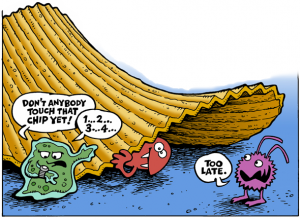 The Five Second Rule: if food falls on the floor you can safely eat it if you pick it up within five seconds. I wrote a popular post on this last year and it’s a topic that resurfaces all of the time — recently in The New York Times.
The Five Second Rule: if food falls on the floor you can safely eat it if you pick it up within five seconds. I wrote a popular post on this last year and it’s a topic that resurfaces all of the time — recently in The New York Times.
The Truth About Five Seconds (or three, or seven)
It’s bogus! In most cases, if bacteria are on the floor, they’ll stick to food almost immediately on contact.
Things that affect how quickly the bacteria cling are the kind of floor; the kind of food; the kind of bacteria; and how long the bacteria have been hanging around on the floor.
Let’s Go For Zero
A food scientist and his students at Clemson University tried to determine if the five second rule has some validity or if it’s just a bunch of bunk.
For their study, they put salmonella (as few as ten of these bacteria can cause stomach issues) on wood, tile, or carpet, and then dropped bologna on them for 5, 30, or 60 seconds. More than 99% of the bacteria were transferred nearly immediately from the wood and tile and a smaller number were transferred from the carpet. Over a number of hours, the number of bacteria that transferred decreased, but thousands per square centimeter still remained on the surfaces after 24 hours. Hundreds hung around for as long as four weeks.
Location, Location: The Sidewalk Is Better Than The Kitchen Floor
Most researchers agree the important thing is not how long food takes a vacation on the floor, but where that stay is. Believe it or not, according to a professor of microbiology and pediatric infectious diseases at the University of Colorado School of Medicine and author of Germ Proof Your Kids, it may be okay to brush off and give back the gummed up bagel that your kid tossed out of the stroller. Pavement has fewer types of germs that cause illnesses than the kitchen floor — which is probably coated with health hazardous bacteria from uncooked meat and chicken juices.
Don’t Retrieve Food From The Kitchen Sink Either
Kitchen sinks have more germs than bathroom sinks and three-quarters of kitchen dish cloths and sponges are heavily contaminated with harmful bacteria like E. coli and salmonella. The bacteria, probably carried into the kitchen by food, kids, or pets, can cause diarrhea or infections with flu-like symptoms (especially dangerous for small children, the elderly, and pregnant women). Bacteria adore the food collected in sponges used to wipe stuff up and can find a happy growing ground nestled in your sponge.


